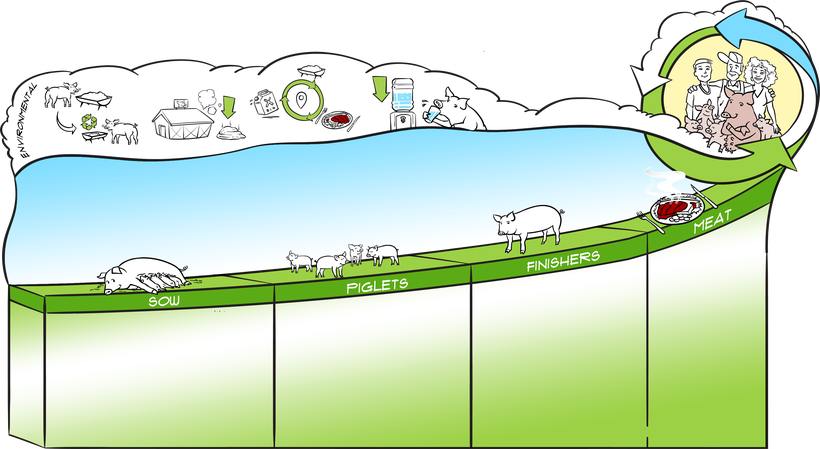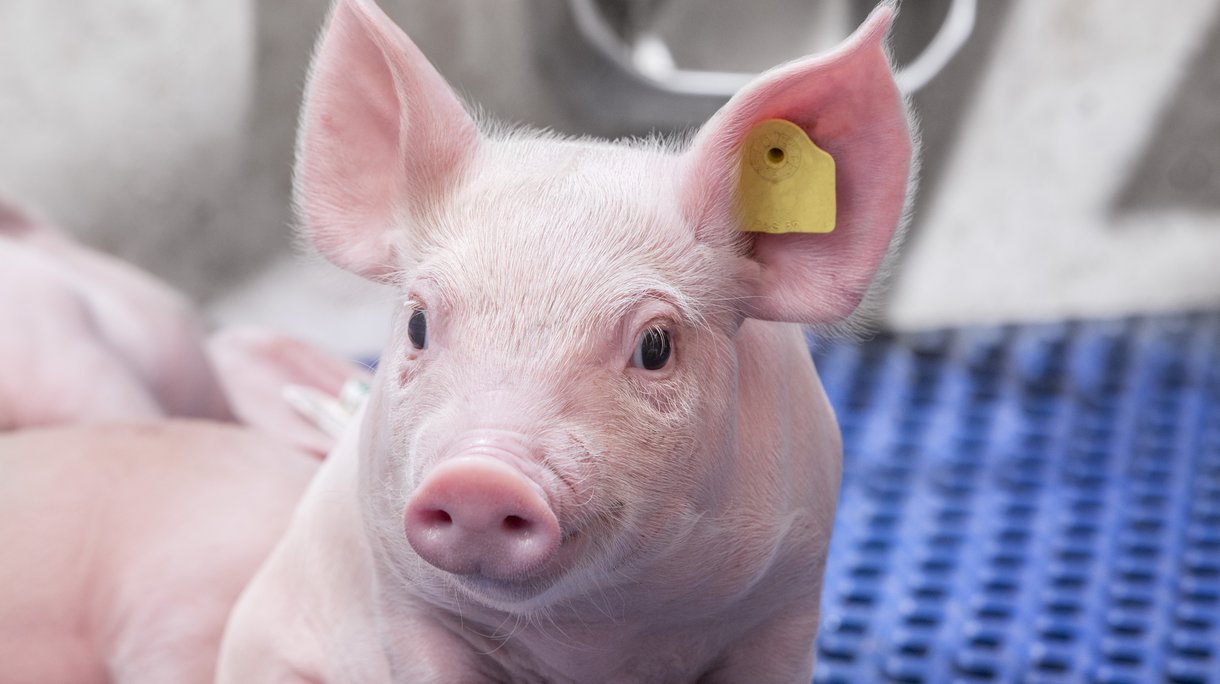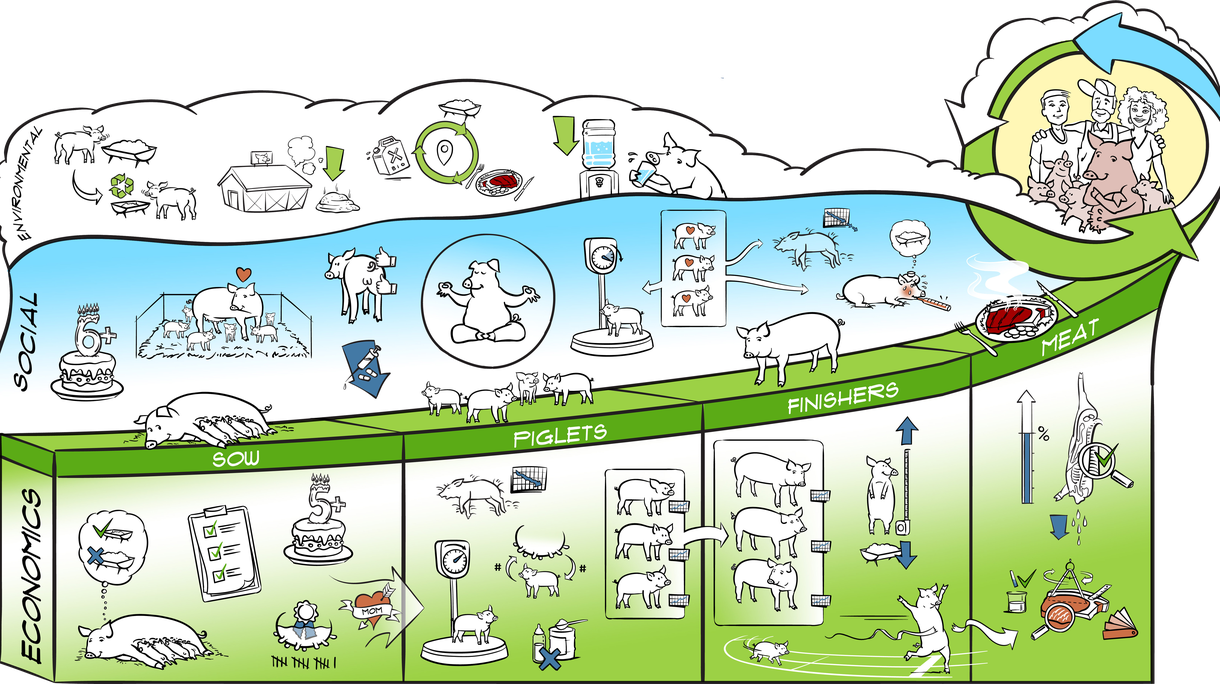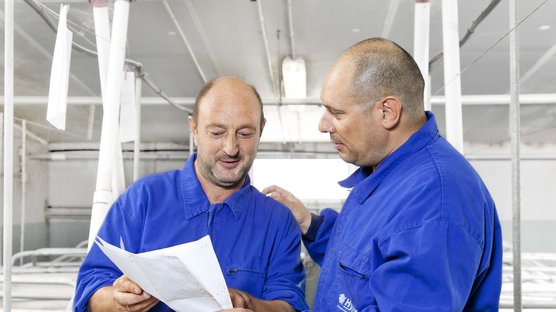
Published on June 22, 2021
Environmental sustainability: the feedprint of pork
Hendrix Genetics raises the bar on economic, social and… environmental sustainability. In addition to the benefits of genetic progress for environmental sustainability, there are other areas of focus to reduce the industry’s footprint. The introduction of sustainable feed conversion is key, in addition to utilization of emission reducing diets and alternative ingredients. All of which will help to resolve the food-feed-fuel conflict and the environmental impact of our sector.
Pork production is increasingly facing consumer concern about the environmental impact of its current production system. The use and impacts on land and soils, air, water, and greenhouse gas emissions all make up the environmental footprint of pork production. The major challenges facing the pig production sector is the need to meet the growing demand for pork, reduce the impact of pork production on the environment, meet higher animal welfare standards, and at the same time ensure the profitability of the sector. In this article, we will focus on ways to improve the environmental sustainability of pork production.
Intensification reduces the footprint
Research from the United States shows a clear downwards trend in the footprint of pork production. Using life cycle assessments of the pork value chain, modelling pork production from 1960 till 2015, the research clearly demonstrates a reduced environmental impact per kg/lb. of pork produced. On average, production weighted metrics declined across all four categories over the assessment period. The largest decrease was seen in land use (75.9%), followed by water use (25.1%), then global warming potential (7.7%), and finally energy use (7.0%). The research concluded that by intensification of pork production, its footprint has reduced dramatically over the last decades.
Feed is the key
It is estimated that the production of 1 kg/2.2 lbs of pork leads to the equivalent of 7.2 kg/15.9 lbs CO2 emissions. Almost half of it comes from feed. The other half comes from land use change, the change in biomass and soil carbon, and on farm processes (fertilizer, manure, and farm machinery). The remainder, about 15%, comes from transport, processing, packaging, and retail. So, the obvious area to target for a reduction in the pork production footprint is feed. This would have an impact both from feed conversion and land use perspectives, i.e. if animals are more efficient, less input is needed. Additionally, if the feed can be sourced from alternative routes, such as food- or fuel-waste streams, this will have an impact on land use as well. Feed conversion has been on top of the list of breeding goals for many years, and significant progress has been made. The process of better feed conversion hasn’t come to an end, not even close.

Pigs are part of the solution
In a circular food system, we want to produce enough food for the world population, while taking our planet’s carrying capacity into account. To achieve this, we need to make optimum use of all biomass. We can prevent biomass losses by using the residues from one chain as raw materials for another (circular system). In such a system, the idea is to reuse residual products where possible, by converting them into valuable animal feed, or into fertilizer, for example. Pigs are omnivores and can convert many forms of residual products into meat and manure. In an ideal circular system, production - and therefore livestock - should result from an optimal processing of the available residual products, whereby the sum of all products meets human nutritional needs.
Sustainable feed conversion
The Hypor breeding program is geared towards delivering self-reliant animals. Animals, that live productive lives and decrease the environmental footprint through the reduction of ‘waste’. Animals that overcome disease challenges, reduce mortality rates and improve efficiency. More efficient animals have a positive impact on land use because they simply eat less (require less input).
In the future, pigs will need to cope well with diets that differ in ingredients, nutrient profile, and quality. Calculating feed conversion rates in a completely different way, using factors like the quality of the diet, manure composition, and the percentage of pig losses from start to finish, will contribute to the discussion of what sustainable feed conversion truly is.
In our current Hypor breeding program, we work on the following topics to reduce the pork production footprint: 1) feed efficiency, or in the future, towards sustainable conversion; the ability to cope with alternative feed ingredients that result in lower emission of greenhouse gases. And 2) survival; every pig that makes it to slaughter is an efficient use of feed and feed ingredients. Mortality rates in all phases of production must be minimized, especially in the finisher phase, where the loss of consumed feed is the highest. In other words, we are breeding for sustainable pigs that fit easily in a circular food system.
Sustainable swine breeding
In the end, all three pathways to sustainability must be addressed to realize the most sustainable swine sector. Hendrix Genetics wants to pave the way towards a more environmentally sustainable swine industry. Environmental sustainability is important for continued success of the swine sector and will also improve social acceptance of our sector. Looking closely at our goals for economic, social, and environmental sustainability in the Hypor breeding program is all part of contributing to Better Breeding Today for a Brighter Life Tomorrow.




